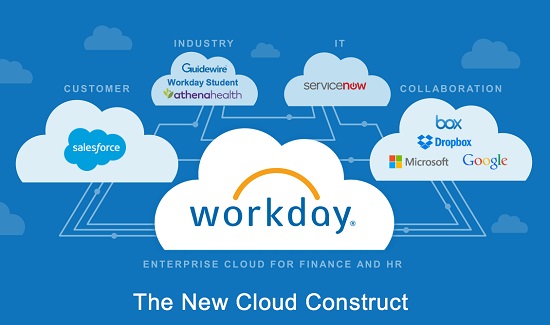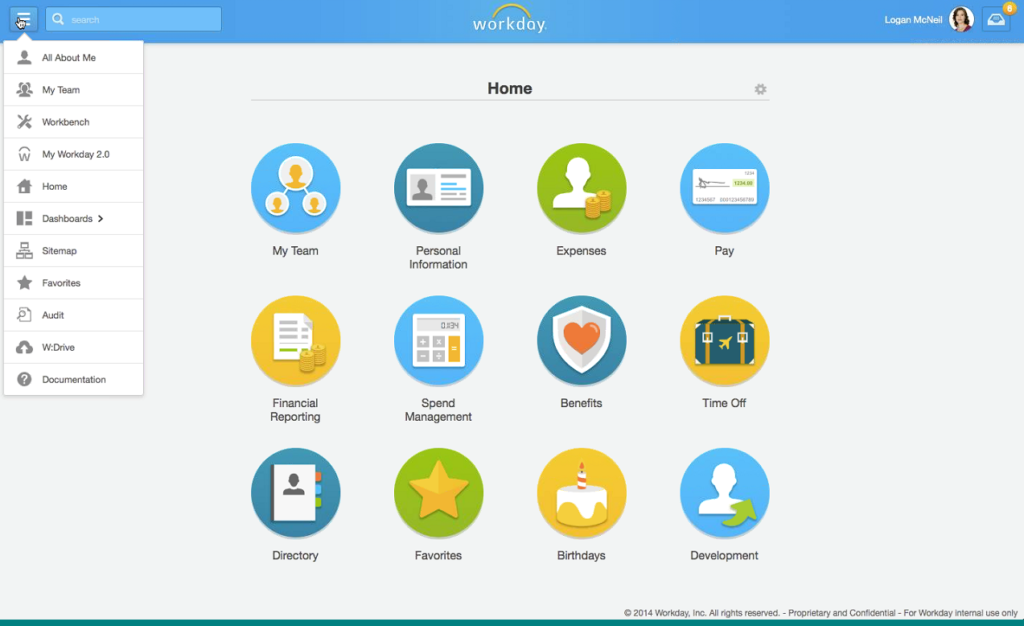
What is Workday?
You may have noticed that both Chris Cruz (CIO & CDT, State of CA) last week and Carl Eschenbach (Partner, Sequoia Capital and Ex-COO, VMware) this week, used Workday as an example of an innovative system. Carl even asked the audience who is familiar with the system and a few raised their hand. In an effort to help the people that didn’t raise their hand, below is a summary of Workday.
Workday was founded by the former CEO of PeopleSoft, David Duffield, and his Chief Strategist, Aneel Bhusri. The company is located in Pleasanton, California. Workday is a Human Capital Management System (HCM) some people even refer to it as an Enterprise Resource Planning system (ERP.) (1) Simply said, it’s the system your company is using to keep and manage your information. Historically companies build modules that performed one or just a few HR functions. Organizations had to purchase those modules from different vendors, and integrate them. There are many benefits to a seamless integration, one of which is that you don’t have to enter the same information in several different places. Unfortunately integration was hard and the systems you purchased from different vendors changed often. Things broke all the time. Even when the same vendor offered a suite of services, integration between the modules wasn’t perfect as some were simply companies they had acquired. A good example is Oracle acquiring Taleo, a recruiting or talent management system for $1.9B (2)
What are my other options? When a HR department goes to market to buy a system to manage peoples’ records, they will likely explore the following options (3):
- Workday
- SAP SuccessFactors
- Oracle Fusion
- UltiPro
- ADP Vantage
- Kronos
- Namely
- PeopleSoft
Here is what Workday looks like. It’s a one stop shop for recruiting, onboarding, learning and development (limited,) compensation benchmarking, performance management, payroll, benefits, time off, and analytics.

Workday is cool because:
- SaaS: All customers are on the same version. The software updates are delivered over the air like an iPhone or Tesla.
- One flexible database: Great flexibility in setting up the business process and data flow.
- Easy integration: Integrating WD with other systems is easy compared to most other HR systems.
- Free upgrades: The WD team is deploying free new capability frequently, at least twice/year. Examples of free functionality upgrades include resume parsing, importing of skills through your LinkedIn account, analytics capabilities, and so on.
- Workday community: This is a community of all customers that teach one another how to do things. Customers can also ask for specific upgrades and, if upvoted by others, the WD team will prioritize those on their roadmap.
- Mobile & Self-serve: The mobile capability is very good. You can do most of your HR business on your phone. The company can let people self-serve to their hearts content.
- Automation: The potential for automation is enormous. (4) One could eliminate HR professionals completely but it could also serve as a tool like in Jeff Welsers’ IBM example with doctors.
Workday downsides:
- Flexibility: The same reason the HCM is great is also the reason it can be configured to be a disaster. Think of the Winchester Mystery house (5) – one could create that in WD very quickly. It’s scary.
- User Interface: The Interface is cool and many love it but I find it too cartoony. It would be good to have more control over the look of your HR System.
- Not for small companies: WD works for mid-sized and large organizations. There are better solutions for companies up to a few thousand employees. The HCM called Namely is probably better in that case.
- Self-serve maintenance: Workday has the WD Community versus traditional customer service. After implementation, customers are expected to upkeep and develop their own system. There is no customer service in the traditional sense of it. That can be intimidating or too much work for many organizations.
Who is a fan? Workday, in the HCM world, compares themselves to the Tesla in the auto world. I think that is true. Most organization are either already on it or migrating to it. Some listed below.

I have experience with several HCMs and like Workday. My favorite part is simple functionality such as the ability to provide a coworker with constructive feedback and do it as quickly as sending a text.
What HR system does your company use? What do you like or dislike about it?
References:
- Summary of past and future ERP and HCM trends. Wikipedia. https://en.wikipedia.org/wiki/Human_resource_management_system
- Oracle Buys Talent Management Solutions Company Taleo for $1.9 Billion. TechCrunch. https://techcrunch.com/2012/02/09/oracle-buys-talent-management-solutions-company-taleo-for-1-9-billion/
- Workday alternatives and competitors: https://www.g2crowd.com/products/workday/competitors/alternatives
- Workday HCM Strengths and Weaknesses. HRLab. http://www.hrlab.com/workday-strengths.php
- Winchester Mystery House. Wikipedia. https://en.wikipedia.org/wiki/Winchester_Mystery_House
NOTE: I am not a Workday representative nor affiliated with the company in any way. This post is meant to be a hopefully helpful summary of the product based on my interaction with it.
6 comments on “What is Workday?”
Comments are closed.



Different organizations have different cultures; for example some organizations allow work at home while others the staff must report at a certain time and this data is recorder through a card system; paid leave vs unpaid leave, paternity leave, taking education leave for a few months, e.t.c.how does Workday incorporate such cultural differences in their system to cater for all customer needs?
Users who have LIKED this comment:
Thank you for this excellent question Patricia. I completely agree with you that the systems and processes you put in place need to not only consider but serve the company culture. Many people don’t think about that but it’s such a critical criteria when purchasing a system that employees will interact with. You are wise to bring this up.
We had a few of those varying needs you mention even within our organization. The different needs of functions such as manufacturing, engineers, sales, or field service were a layer of complexity. Furthermore, it’s a global operation — there are subtleties across not only laws but also work norms. We had to be very thoughtful and strategic when creating different workflows for each group so that we keep the culture similar but cater to the different needs. The good news is that the system is so customizable that if you know what you are looking to do — it can be done. The dangerous part is that many people want to over-customize and that is hard to maintain long term.
Insightful perspective, Boryana. I have used a few of the systems you reference, namely PeopleSoft and SAP, and been involved with implementation of SAP when working for one of the big systems integrators. Even after a couple of decades, SAP still reminds me of its legacy heritage, meaning that the user interface isn’t enticing and most applications are not intuitive. To add better flow requires real software development, and that is expensive. SAP was built for manufacturing resource planning (MRPII, later called ERP), was heavily focused on material movement and product assembly/construction. The human resources aspects came later in response to market demand from what I can recall. PeopleSoft, because its roots were in human resources information systems (HRIS), may have a bit better interface, but not by a lot. Similarly, there are features that are not intuitive, and again require expensive custom development to enhance. My current firm used Ceridian, which always reminded me of ADP, and we migrated to the Dayforce HCM cloud-based solution in 2016. We run a hybrid environment that uses SAP for HR, Taleo/Oracle for recruiting, and Dayforce HCM for payroll.
Users who have LIKED this comment:
Thank you, David. Helpful additional information. I also really appreciate you sharing what systems your organization is using. It’s always interesting to me to hear what other companies do in that regard. One question: Are you a fan of A) Best in breed (Taleo for ATS, Dayforce of Payroll, etc.) or do you think that B) One system that does it all is better? The “one system” route has the benefits of one seamless database but not all functionality is as mature as what one could find with other best in breed systems.
Thanks for a more detailed look at Workday, Boryana. I agree that one of the biggest strengths is a fully integrated solution for payroll, vacation, performance, onboarding etc. I used Workday many years ago as an intern, and remember it being slow (Java based?) and without much support on mobile. As you mention, looks like they got serious on the mobile/tablet front with modern apps for use-on-the-go.
In interesting news, the SaaS company is now exploring a PaaS service: http://www.ciodive.com/news/workday-opens-up-about-plans-to-enter-the-paas-market/446867/
Users who have LIKED this comment:
Thank you for sharing, Gaurav! Very cool! I do see how that move will be very popular. I’ve met more than a 2 dozen HRIS Architects or Analysts that have decided to devote their career on Workday. People spent their careers on PeopleSoft — it will be interesting to see if the same will happen here.
The overall performance and the mobile app have definitely improved. I am impressed by their rate of improvement, given that the company is becoming much bigger and is facing numerous competing priorities.
A product review site I found: https://www.trustradius.com/products/workday-hcm/reviews